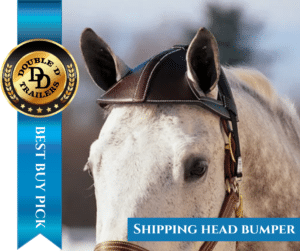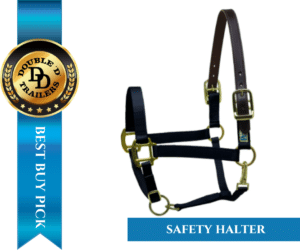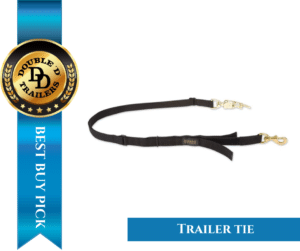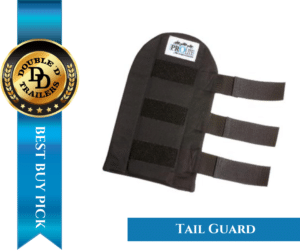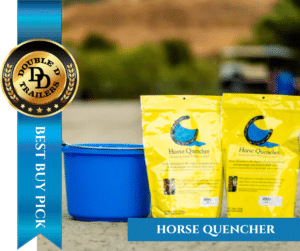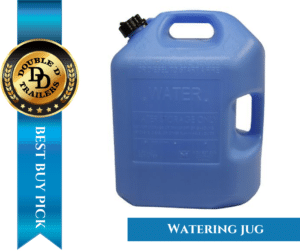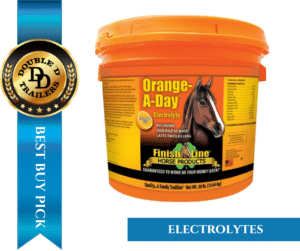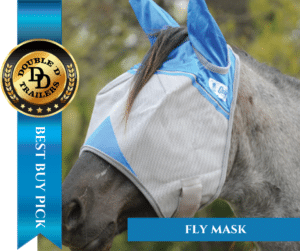Double D Trailer’s ‘Best Buy’ List of Trailer Safety Gear
At Double D Trailers, we prioritize safety in every aspect, from our trailer designs to the gear we recommend for your horses. In this updated guide, we’ve curated a list of essential safety gear for ensuring your equine companions travel in comfort and security.
Head Protection: Advanced Head Bumpers
If you have a horse that tends to rear up in the trailer, then a head bumper is an absolute must. This will provide extra protection to his poll area during travel. In one case we know of, a veterinarian stated that a head bumper surely prevented a brain bleed after the horse reared into the ceiling of the trailer.
Our favorite type of bumper is the kind that easily clips in place without needing to remove the halter. The Shipping Head Bumper from Dover Saddlery is an excellent example with a leather exterior and a thick felt lining. The clips that attach to the halter are made of metal instead of the plastic you will find on other brands.
> The SafeBump roof from Double D Trailers is also specially designed to protect your horse’s head on impact. Learn more here.
Protect Those Delicate Legs: Leg Wraps
Let’s face it. Horse legs are delicate! For such a powerful and fast moving creature, horse legs are very prone to injury. Once a serious leg injury occurs, it can be difficult to rehab because horses are almost always on their feet. Typical shipping wraps with quilted pads and wrapped bandages should extend from below the coronary band and the bulbs of the heel up to the knee or hock joint. These long bandage wraps can also be a royal pain to roll up and wash.
Luckily, there is an easier option! Shipping boots cover the same area and come with quick Velcro straps. The main advantage here is that they can be applied quickly, provide the same protection, and are easier to store and wash.
StateLine Tack offers a great set of shipping boots manufactured by Amigo. We like that these boots provide full coverage from the fetlocks all the way up to the knee and hock joints.
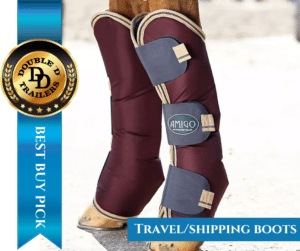
Safety Breakaway Halter
When a horse panics in the horse trailer, the worst can happen in the blink of an eye. If your horse is tied using a non-breakable nylon lead and halter, a bad situation can turn into a fatal accident. That is why we highly recommend you use breakaway style halters.
A breakaway halter, like the one found at The Equestrian Collection has a full leather crown piece that snaps under a panic load. We prefer this type of halter over the kind that only has a small 3” leather section on the side of the harness.
Breakaway Trailer Ties
Likewise, a breakaway set of trailer ties, like the Tie-Safe Breakaway Horse Trailer Ties from Smith Brother’s will release under a panic load. These ties have a patented Velcro design that releases without any snap-back danger.
Regardless of which breakaway trailer tie you choose, make sure it is long enough that your horse is able to drop their head to clear particulate matter from his respiratory tract. This is one step that will help your horse avoid stress and health problems like stress-induced shipping fever.
No More Rubs and Bruises: Tail Wrap
Tail rubs are painful and unsightly, but a tail guard can protect the top of the tail from bumps and rubs. Alyse from Hastilow USA Saddlery shared, “We always recommend using a tail guard over top of a tail wrap to ensure the entire coccyx is protected.”
One of the best brands to use is the Prolite Tail Guard. The foam used in this product absorbs and disperses pressure and impact, which cushions and protects the dock of the tail and bone.
Ensure Proper Nutrition and Hydration: Hay Nets and a Water Bucket
If you are traveling a long distance, it is a good idea to provide both hay and water for your horse during the course of the trip. Dr. Hannah Mueller of the Cedarbrook Veterinary Care in Snohomish, Washington recommends a hay bag for each horse during travel. You should consider a slow feeder type of bag to minimize choking if your horse tends to scarf down his food.
More importantly, offer water to your horse at each rest stop if you are traveling long distances. Some horses are picky about foreign tasting water, so you may want to try some water flavoring to entice your horse to take a drink. One of our favorite products is called HorseQuencher. This product is a mix of all natural grains and flavorings that can be added to water to encourage the horse to drink. It comes in several flavors including apple, peppermint, butterscotch, and even root beer!
You can check your horse’s hydration level by looking at the color of their gums and capillary refill time (CRT). They should have pale pink gums and the CRT should be less than 2 seconds. You can also check for skin tenting by squeezing the skin on their neck or shoulder. It should bounce back easily when pinched. If any of these tests fail, then your horse is dehydrated. Remember, proper ventilation and roofing material play a major role in regulating the internal temperature of your trailer. A sweltering hot trailer will cause excessive sweating that leads to dehydration.
In order to transport your water during travel, we recommend the 6-Gallon Self-Venting Water Can available from Dover Saddlery. This can is made of high –density polyethylene so it is durable, rust proof, and dent-proof. This container is both convenient and extremely smart to have on hand.
Be Prepared: Medical supplies
Dr. Mueller also says, “You should always travel with a complete first aid kit!” Items in this kit should include a thermometer, stethoscope, headlamp, bandages, scissors, and would treatment supplies. Also bring things like banamine (used to treat colic), Bute, neo poly bac eye ointment, triple antibiotic for wounds, probiotics, and Echinacea.
One way to prevent dehydration is to provide your horse with electrolytes. “Electrolytes can help encourage your horse to drink and stay hydrated so I recommend orally dowsing electrolytes starting the day before, during and for a day or two after transport.” FinishLineHorse has a nice selection of vitamins and supplements but we especially like their Orange-a-Day Electrolyte supplement.
Road Debris in Their Eyes: Fly Mask
Fly masks aren’t just used to keep flies away from your horse’s eyes. They are also great at protecting from road debris while traveling. This is an especially good idea if you have a stock trailer with open sides. Small rocks, salt chunks, or dirt from dump trucks can cause havoc while driving down the road.
If you are looking a unique fly mask option, check out the Crusader Fly Mask from the Cashel Company. This fly mask provides full coverage over the horse’s ears.
Bonus Tip - Keep Them Warm, But Not TOO Warm: Blanket
Horses thrive in cooler temperatures around 50-60 degrees Fahrenheit, so a blanket is only needed in certain situations. Consider whether your horse is body clipped, what the ventilation is like in the trailer, and also if your horse has traveling companions. All of these will influence whether or not your horse needs a blanket to stay warm.
An unnecessary blanket can cause your horse to sweat, which will accelerate dehydration and make them more prone to chill. If you decide a blanket is necessary, be sure that the straps are properly fastened so that it doesn’t slide off or cause painful rubs. There are many choices when it comes to blankets, but we found an excellent selection at the Dover Saddlery. We like this company because they have a 100% satisfaction guarantee and fantastic customer service.
We hope our recommendations for horse trailer safety gear help you make informed decisions for your horse's well-being!
> Learn more about how our company is committed to equine safety.

